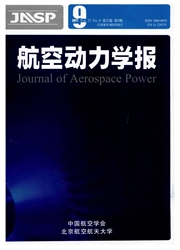

 中文摘要:
中文摘要:
选取齿轮传动涡扇发动机低压转子为研究对象,以结构效率评估参数量化其动力学特性.通过建立低压转子简化模型,对低压转子关键结构参数(即支承方案、支点支承刚度)对其动力学特性的影响规律进行了研究,阐明了低压转子结构参数与其动力学特性的关系,并对其支承方案及支承刚度进行了优选设计.当低压转子支承方案为1-0-1,两支点支承刚度分别为5.84×10^7N/m和5.90×10^7N/m时,转子动力学性能较优,此时转子角向抗变形能力较好,前两阶临界转速分布满足共振裕度设计要求,且分布于小的转速区间内.
 英文摘要:
英文摘要:
Takeing the low pressure rotor in geared turbofan as object, the influences of structural parameters (i. e. , supporting scheme and stiffness of supporting point) of low pressure rotor on its dynamics were studied by building simplified model of low pressure ro- tor and quantifying its dynamics through structural efficiency evaluation parameters. Mean- while, the optimization design of the supporting scheme and stiffness of supporting point was carried out based on the relationship of the structural parameters and dynamics of the rotor. The optimization design of the supporting scheme and stiffness of supporting point was pres- ented. As a result, it indicates that the dynamics performance of the rotor is optimal when the supporting scheme is 1-0-1 and stiffness of supporting points is 5.84 × 10^7 N/m and 5.90 × 10^7 N/m, respectively. At that moment, the angular non-deformability of the rotor is pretty good, and the distribution of the first two critical rotational speeds satisfies the re- quirements for resonance margin design and is limited within a small speed extent as well.
 同期刊论文项目
同期刊论文项目
 同项目期刊论文
同项目期刊论文
 期刊信息
期刊信息
